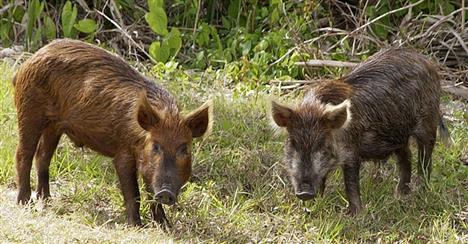Stakeholders coalesce to tackle state’s feral hog problem
by March 23, 2021 2:07 pm 2,192 views

The COVID-19 pandemic has slowed many human activities, but it hasn’t stopped feral hogs from reproducing and causing damage to agriculture fields throughout the state. During 2021, the Cooperative Extension Service, in partnership with the Arkansas Department of Agriculture, the Arkansas Game and Fish Commission and other partnering organizations, is reaching out to residents to help reduce feral hog populations.
Luke Lewis, Assistant Chief of the AGFC’s Wildlife Division, said while the COVID-19 pandemic has impacted operations in multiple state agencies, the problems faced by Arkansas landowners aren’t going away.
“Even though COVID has slowed up human activity, it hasn’t stopped feral hogs from reproducing and causing damage,” Lewis said.
A U.S. Department of Agriculture publication cites a “likely conservative annual estimate” of damage from feral hogs at $1.5 billion across the United States. While feral hog populations are concentrated in the southeastern United States, there are also scattered populations in Vermont, New Hampshire, Pennsylvania, Ohio, Indiana, Virginia, California, Oregon, Nevada, Utah, Arizona, Hawaii and New Mexico.
Feral hogs cause damage to row crops, pastures, and wildlife habitat. Most Arkansans who have experienced feral hog damage on their property understand the risk of their populations getting out of control. There is no definitive estimate of how many feral hogs roam in Arkansas.
A 2018 assessment conducted by the University of Arkansas System Division of Agriculture found that only 7% of landowners who reported feral hog activity on their property were very confident in their ability to protect their lands from risks associated with feral hogs. About 30% of landowners who reported no feral hog activity on their lands said they were confident in their abilities to protect their respective lands.
Becky McPeake, extension wildlife specialist for the Division of Agriculture, said that 84% of survey respondents reported shooting feral hogs during daylight hours, with 70% reporting they trapped feral hogs.
“We need to do everything we can, which means using whatever tools we have to reduce feral hogs,” McPeake said. “However, we need to think strategically about how and when to use those tools.”
She said feral hogs tend to learn from “close calls” and further adapt to environmental threats.
“Shooting at them at the wrong time can train the survivors to avoid people and traps, which hurts future efforts at removing them,” she said.
McPeake recommends landowners prepare strategies that may include shooting and other methods after trapping “sounders.” Sounders are groups of females and their piglets, which tend to remain local. Wandering boars, in contrast, may remain in a given area for a shorter time before moving on.
As an educational outreach, Cooperative Extension Service agents throughout the state are available to teach residents how to employ cellular trapping systems, which involve the use of game cameras and remotely triggered gates to trap entire sounders.
Residents with unwanted feral hogs on their property can have them removed by contacting USDA Animal Plant Health Inspection Service Wildlife Services at 501-835-2318. They are leading the statewide effort at feral hog removal, one pig at a time, with partners on the Arkansas Feral Hog Eradication Task Force.
Call your local county extension office for more information about feral hogs, or to volunteer your property as a demonstration site.
